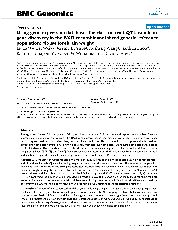摘要
Background: Successful strategies for QTL gene identification benefit from combined experimental and bioinformatic approaches. Unique design aspects of the BXD recombinant inbred line mapping panel allow use of archived gene microarray expression data to filter likely from unlikely candidates. This prompted us to propose a simple five-filter protocol for candidate nomination. To filter more likely from less likely candidates, we required candidate genes near to the QTL to have mRNA abundance that correlated with the phenotype among the BXD lines as well as differed between the parental lines C57BL/6J and DBA/2J. We also required verification of mRNA abundance by an independent method, and finally we required either differences in protein levels or confirmed DNA sequence differences.
Results: QTL mapping of mouse forebrain weight in 34 BXD RI lines found significant association on chromosomes 1 and 11, with each C57BL/6J allele increasing weight by more than half a standard deviation. The intersection of gene lists that were within +/- 10 Mb of the strongest associated location, that had forebrain mRNA abundance correlated with forebrain weight among the BXD, and that had forebrain mRNA abundance differing between C57BL/6J and DBA/2J, produced two candidates, Tnni1 (troponin 1) and Asb3 (ankyrin repeat and SOCS box-containing protein 3). Quantitative RT-PCR confirmed the direction of an increased expression in C57BL/6J genotype over the DBA/2J genotype for both genes, a difference that translated to a 2-fold difference in Asb3 protein. Although Tnni1 protein differences could not be confirmed, a 273 bp indel polymorphism was discovered 1 Kb upstream of the transcription start site.
Conclusion: Delivery of well supported candidate genes following a single quantitative trait locus mapping experiment is difficult. However, by combining available gene expression data with QTL mapping, we illustrated a five-filter protocol that nominated Asb3 and Tnni1 as candidates affecting increased mouse forebrain weight. We recommend our approach when (1) investigators are working with phenotypic differences between C57BL/6J and DBA/2J, and (2) gene expression data are available on http://www.genenetwork.org that relate to the phenotype of interest. Under these circumstances, measurement of the phenotype in the BXD lines will likely also deliver excellent candidate genes.
- 出版日期2008-9-25
- 单位南通大学
